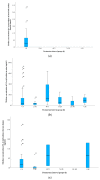Heroin-Related Fatalities in Jeddah, Saudi Arabia, between 2008 and 2018
- PMID: 36977013
- PMCID: PMC10099738
- DOI: 10.3390/toxics11030248
Heroin-Related Fatalities in Jeddah, Saudi Arabia, between 2008 and 2018
Abstract
To date, epidemiological studies have not evaluated heroin-related deaths in the Middle East and North African regions, especially Saudi Arabia. All heroin-related postmortem cases reported at the Jeddah Poison Control Center (JPCC) over a 10-year period (21 January 2008 to 31 July 2018) were reviewed. In addition, liquid chromatography electrospray ionization tandem mass spectrometry (LC/ESI-MS/MS) was utilized to determine the 6-monoacetylmorphine (6-MAM), 6-acetylcodeine (6-AC), morphine (MOR), and codeine contents in unhydrolyzed postmortem specimens. Ninety-seven heroin-related deaths were assessed in this study, and they represented 2% of the total postmortem cases at the JPCC (median age, 38; 98% male). In the blood, urine, vitreous humor, and bile samples, the median morphine concentrations were 280 ng/mL, 1400 ng/mL, 90 ng/mL, and 2200 ng/mL, respectively; 6-MAM was detected in 60%, 100%, 99%, and 59% of the samples, respectively; and 6-AC was detected in 24%, 68%, 50%, and 30% of the samples, respectively. The highest number of deaths (33% of total cases) was observed in the 21-30 age group. In addition, 61% of cases were classified as "rapid deaths," while 24% were classified as "delayed deaths." The majority (76%) of deaths were accidental; 7% were from suicide; 5% were from homicide; and 11% were undetermined. This is the first epidemiological study to investigate heroin-related fatalities in Saudi Arabia and the Middle East and North African region. The rate of heroin-related deaths in Jeddah remained stable but increased slightly at the end of the study period. Most patients were heroin-dependent abusers and from the middle-aged group. The availability of urine, vitreous humor, and bile specimens provided valuable information regarding the opioids that were administered and the survival time following heroin injection.
Keywords: LC-MS/MS; forensic toxicology; opiates; opioids; postmortem.
Conflict of interest statement
The authors have no conflict of interest to declare.
Figures








Similar articles
-
A Quantitative and Comparative Study of Heroin-Related Metabolites in Different Postmortem Fluids and Tissues.Toxics. 2025 Mar 20;13(3):229. doi: 10.3390/toxics13030229. Toxics. 2025. PMID: 40137556 Free PMC article.
-
Postmortem Fluid Concentrations of Heroin Biomarkers and Their Metabolites.J Forensic Sci. 2020 Mar;65(2):570-579. doi: 10.1111/1556-4029.14200. Epub 2019 Sep 30. J Forensic Sci. 2020. PMID: 31566759
-
Methamphetamine-related postmortem cases in Jeddah, Saudi Arabia.Forensic Sci Int. 2021 Apr;321:110746. doi: 10.1016/j.forsciint.2021.110746. Epub 2021 Feb 26. Forensic Sci Int. 2021. PMID: 33676238
-
Post-Mortem Analysis of Heroin Biomarkers, Morphine and Codeine in Stomach Wall Tissue in Heroin-Related Deaths.Toxics. 2022 Aug 14;10(8):473. doi: 10.3390/toxics10080473. Toxics. 2022. PMID: 36006152 Free PMC article.
-
Postmortem Liver and Kidney Tissue Concentrations of Heroin Biomarkers and Their Metabolites in Heroin-Related Fatalities*†.J Forensic Sci. 2020 Nov;65(6):2087-2093. doi: 10.1111/1556-4029.14537. Epub 2020 Aug 17. J Forensic Sci. 2020. PMID: 33460103
Cited by
-
Special issues in forensic toxicology in the Middle East and North Africa (MENA) region: The importance of toxicology amid MENA drug challenges.Saudi Pharm J. 2024 Jun;32(6):102071. doi: 10.1016/j.jsps.2024.102071. Epub 2024 Apr 20. Saudi Pharm J. 2024. PMID: 38690208 Free PMC article. No abstract available.
-
A Quantitative and Comparative Study of Heroin-Related Metabolites in Different Postmortem Fluids and Tissues.Toxics. 2025 Mar 20;13(3):229. doi: 10.3390/toxics13030229. Toxics. 2025. PMID: 40137556 Free PMC article.
-
Substance misuse disorder in Saudi Arabia: A comprehensive examination of current demographic patterns, trends, and intervention requirements.Saudi Pharm J. 2024 Oct;32(10):102163. doi: 10.1016/j.jsps.2024.102163. Epub 2024 Aug 16. Saudi Pharm J. 2024. PMID: 39262681 Free PMC article.
-
Mercy killing of a 72-year-old woman through heroin intoxication.J Forensic Sci. 2025 Jan;70(1):392-397. doi: 10.1111/1556-4029.15637. Epub 2024 Nov 7. J Forensic Sci. 2025. PMID: 39508284 Free PMC article.
-
Exploring the Landscape of Adult Acute Poisoning in Saudi Arabia: A Comprehensive Narrative Review.Cureus. 2024 Aug 14;16(8):e66842. doi: 10.7759/cureus.66842. eCollection 2024 Aug. Cureus. 2024. PMID: 39280539 Free PMC article. Review.
References
-
- United Nation Office on Drugs and Crime . World Drug Report 2022. United Nations Publication; Vienna, Austria: 2022. [(accessed on 20 January 2023)]. Available online: https://www.unodc.org/unodc/en/data-and-analysis/world-drug-report-2022.....
-
- Thaulow C.H., Øiestad Å.M.L., Rogde S., Andersen J.M., Høiseth G., Handal M., Mørland J., Vindenes V. Can Measurements of Heroin Metabolites in Post-Mortem Matrices Other than Peripheral Blood Indicate If Death Was Rapid or Delayed? Forensic Sci. Int. 2018;290:121–128. doi: 10.1016/j.forsciint.2018.06.041. - DOI - PubMed
-
- European Monitoring Center for Drugs and Drug Addiction, Drug-Related Deaths and Mortality Rates in Europe. 2019. [(accessed on 20 January 2023)]. Available online: https://www.emcdda.europa.eu/topics/drug-related-deaths_en.
LinkOut - more resources
Full Text Sources

